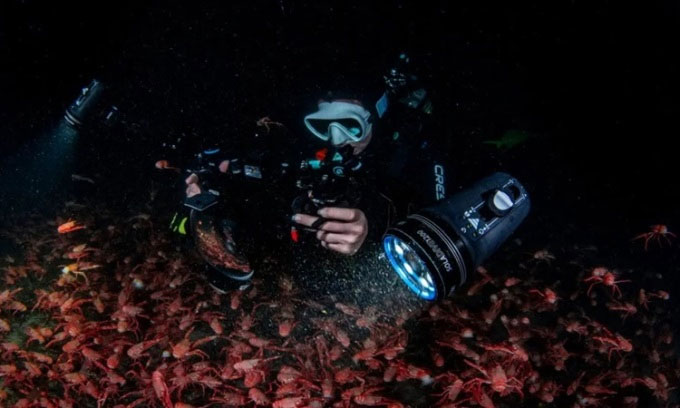Carpets of tuna and crabs cover the California seabed
Divers and marine biologists encountered tuna crabs piling up on the seabed near San Diego due to being swept close to shore by ocean currents.
When underwater videographer Anna Sagatov was diving at night off La Jolla Shores beach in San Diego in late April, she witnessed an unexpected sight. The seabed turns red because crab beds pile up on top of each other. Spinning and shifting with the ocean currents, the crabs stretch as far as the diving lights can illuminate, according to Sagatov. The red crabs she and many others saw off the coast of San Diego were tuna crabs , according to Info Club .

Anna Sagatov took photos with a school of tuna crabs at a depth of more than 18 meters below the sea surface. (Photo: Anna Sagatov).
The shallow waters around southern California are not familiar habitat for tuna crabs. They usually live around Baja California, Mexico. But this is the second time in six years they have appeared in this area. Some experts speculate they may have been pushed into San Diego's nearshore canyon by nutrient-rich ocean currents stemming from El Nino, when warmer oceans release more heat into the air, creating currents. Changeable ocean currents and air pressure fluctuations in the equatorial Pacific Ocean. The event could signal changes in the region's climate. At the same time, the tuna crab gathering provides scientists and divers like Sagatov with close-up images of marine life that often ends up in the bellies of tuna.
Sagatov witnesses collective cannibalism among crabs. Although tuna crabs specialize in eating plankton, they are also opportunistic predators at the end of their life cycle, so they are willing to eat their own species.
Tuna crabs are more closely related to hermit crabs than true crabs , although they have evolved similar characteristics. Their name comes from the fact that they are a favorite food source for large fish such as tuna. At the end of their life cycle, tuna crabs live just above the continental crust, becoming bottom feeders. During this period, they often move along the water column in search of plankton, so they are easily swept north by wind, tides and ocean currents. At the bottom of Scripps Canyon under the sea, tuna crabs pile up in stacks of thousands. For local predators, this is lucrative bait.
This year's and 2018's tuna crab gatherings are a scientific mystery, according to Megan Cimino, a research assistant at the Institute of Marine Sciences at the University of California, Santa Cruz. When the tuna crabs last appeared, her research team found that their movements in California were associated with unusually strong ocean currents that originate in Baja, but do not always coincide with El Nino. According to her, the new event signals "something different is happening in the ocean". While the link between tuna crab stocks and El Nino remains unclear, climate change could lead to more variable ocean conditions.
Due to the cold water in Scripps Canyon, tuna crabs will not last long after reaching San Diego. Collective deaths of crabs lead to stranding events, in which their bodies wash up on the beach, dyeing the sand and surrounding sea red. In another case, the same ocean current can bring the crabs back to the open sea.
- The number of tuna crabs migrated along the US seabed
- Thick red crab carpet awaits death on California beach
- The stranded crab dyes red the California coast
- Thousands of crabs dyed red American beaches
- Rare bluefin tuna appears in the UK
- Pacific Ocean at risk of depleting tuna resources
- Why bluefin tuna in Japan cost millions of dollars?
- Three-tuna tuna causes turmoil in the salmon farm
- Top of unprecedented species of crabs
- Tuna fishing by new methods increases productivity
- Scientists are tame bluefin tuna to get enough sushi ingredients
- Can catch tuna 'super terrible' weighs 411.6kg
 Surprised: Fish that live in the dark ocean still see colors
Surprised: Fish that live in the dark ocean still see colors Japan suddenly caught the creature that caused the earthquake in the legend
Japan suddenly caught the creature that caused the earthquake in the legend A series of gray whale carcasses washed ashore on California's coast
A series of gray whale carcasses washed ashore on California's coast Compare the size of shark species in the world
Compare the size of shark species in the world